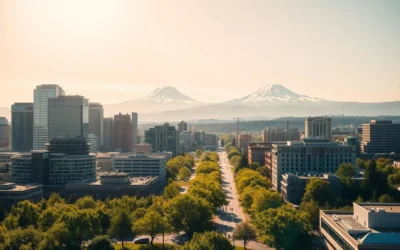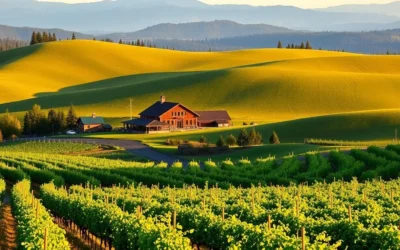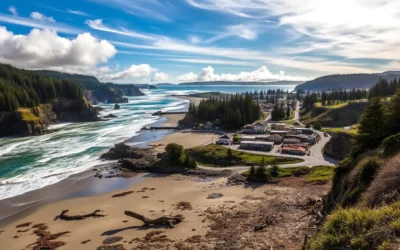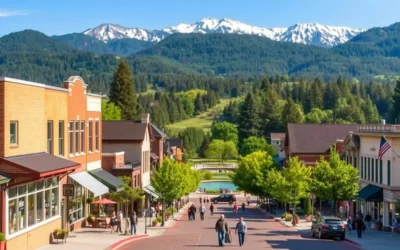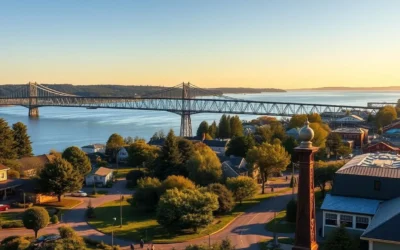Imagine standing at the foot of towering sand dunes that stretch as far as the eye can see, with the sound of the Pacific Ocean waves crashing in the distance. The Oregon Dunes National Recreation Area is a breathtaking destination that offers an unforgettable experience.
This 40-mile stretch of coastline between Florence and Coos Bay is home to some of the world’s largest coastal sand dunes, with peaks reaching as high as 500 feet. As you explore this unique landscape, you’ll discover a diverse range of ecosystems, from forest to desert and ocean.
With numerous activities to enjoy, including hiking, sandboarding, and wildlife watching, you’re sure to have an adventure of a lifetime. Get ready to uncover the top picks for making the most of your visit to this incredible destination.
Discovering the Otherworldly Landscape of Oregon Dunes
As you step into the Oregon Dunes National Recreation Area, you’ll be transported to an otherworldly landscape that will leave you in awe. The Oregon Dunes are a natural wonder that has been shaped by millions of years of geological activity.
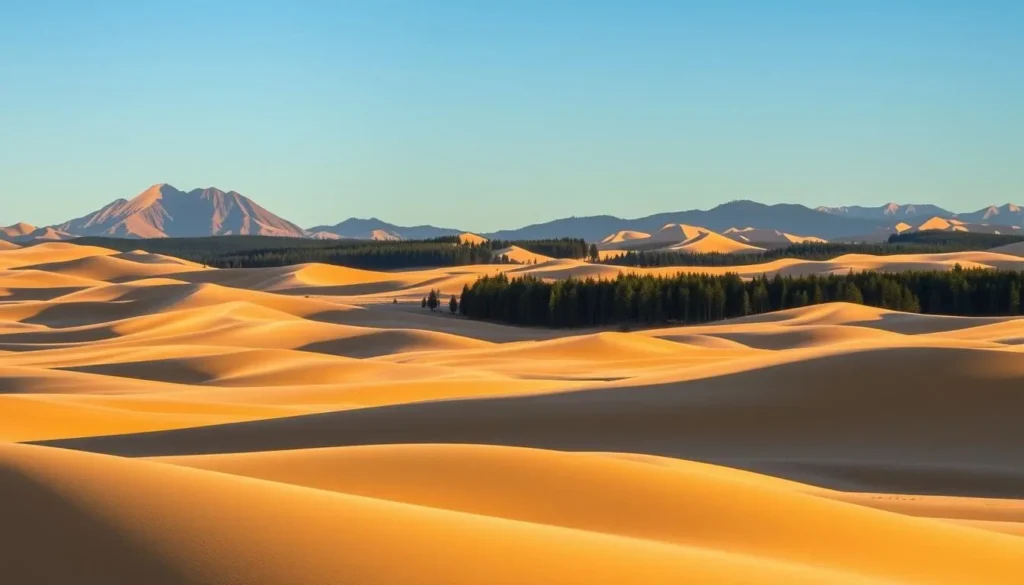
The Formation and History of the Dunes
The dunes started forming 12 to 26 million years ago through the gradual erosion of the Coast Range mountains. The sand was then pushed back inland by tides, currents, waves, and wind, creating the massive dunes we see today. This process continued until about 7,000 years ago, after the eruption of Mount Mazama, when the dunes grew to their current size.
A Unique Ecosystem: Where Forest Meets Desert and Ocean
The Oregon Dunes create a unique ecosystem where three distinct environments converge: dense coastal forests, sprawling sand dunes, and the Pacific Ocean. This convergence supports a diverse range of plant and animal life, making it a fascinating place to explore. The dunes can reach heights of up to 500 feet above sea level, creating a dramatic landscape.
Planning Your Visit to Oregon Dunes National Recreation Area
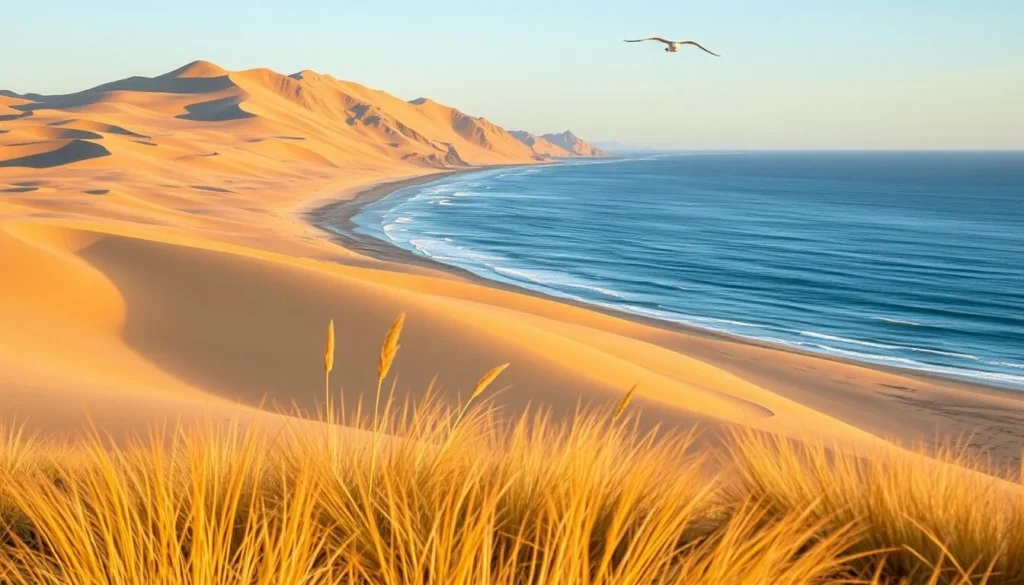
To make the most of your trip to the Oregon Dunes, understanding the best times to visit and what to expect is crucial. The Oregon Dunes National Recreation Area is a unique and awe-inspiring landscape, and visitors have a responsibility to take special care when visiting.
Best Time to Visit and Weather Considerations
The Oregon Dunes are enjoyable year-round, but the weather varies significantly by season. Summer (June through September) offers the warmest and driest weather, with temperatures ranging from 60-75°F.
For those who prefer fewer crowds, consider visiting during spring (April-May) or fall (October-November), when the weather is still mild, though you should be prepared for more frequent coastal rain showers.
Essential Tips for First-Time Visitors
Before heading out, make sure to purchase any necessary Forest Service recreation passes and check current conditions at the Oregon Dunes Visitor Center in Reedsport.
- Pack essentials including sturdy footwear, sun protection, plenty of water, and layers of clothing.
- Be aware of the Western snowy plover nesting season (March 15 to September 15), which may restrict access to certain beach areas.
- Follow Leave No Trace principles throughout your visit.
By being mindful of these factors, you can have a safe and enjoyable visit to the dunes while helping to preserve this unique recreation area for future visitors.
Hiking Adventures Through Towering Sand Mountains
Explore the Oregon Dunes on foot and discover a landscape that is as challenging as it is beautiful. The Oregon Dunes National Recreation Area offers a unique hiking experience that combines towering sand mountains and breathtaking coastal views.
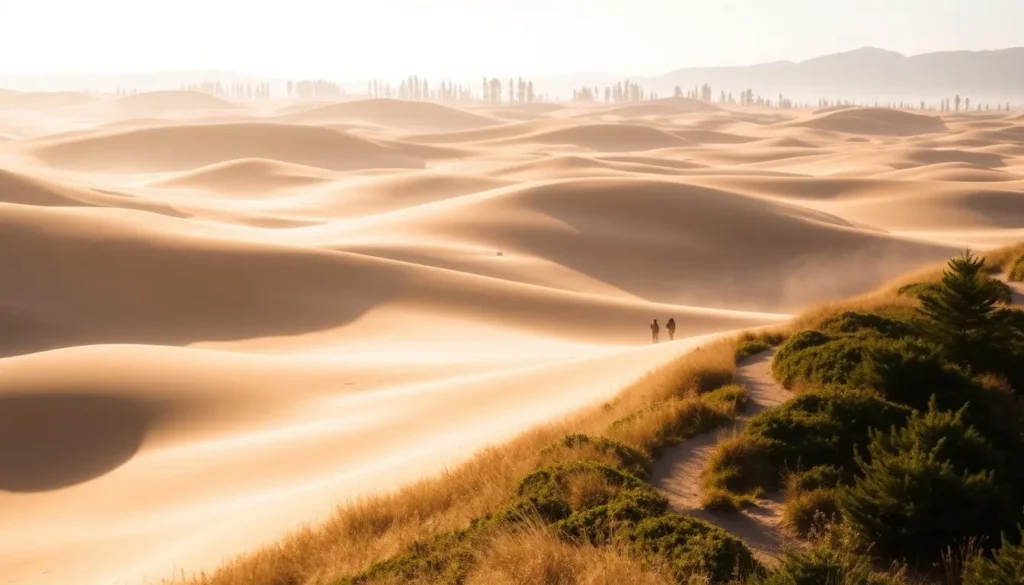
Top Hiking Trails in the Oregon Dunes
The Oregon Dunes Day Use Area is the perfect starting point for your hiking adventure, featuring a viewing platform overlooking the dune landscape and a short trail leading to the beach. For a more challenging experience, explore the Tahkenitch Dunes trail system, which offers an 8-mile network of paths. The John Dellenback Dunes Trail is another must-try route, taking you through diverse ecosystems from forest to open dunes and eventually to the beach.
Tips for Navigating the Challenging Sand Terrain
Be prepared for the unique challenges of hiking in sand. Walking in loose, dry sand can be physically demanding, so plan shorter routes. You’ll find hiking easier in the morning when the sand is still damp from dew, which also provides the perfect opportunity to spot wildlife tracks. Remember to bring a map and compass or GPS device to navigate the open dune fields.
Thrilling Off-Road Adventures in the Dunes
Get ready for an adrenaline rush like no other at the Oregon Dunes National Recreation Area. With about 30% of the area designated for off-road vehicle use, it’s a premier OHV destination on the West Coast.

Best Areas for Off-Road Vehicle Exploration
The most spectacular off-road adventures await you south of Reedsport, where the tallest and most impressive dunes are located. You’ll find massive formations at the John Dellenback area and the Umpqua Dunes at Winchester Bay. Three main designated OHV areas are available: South Jetty near Florence, Umpqua Dunes near Winchester Bay, and Spinreel near North Bend.
Rental Options and Guided Tours
If you don’t have your own vehicle, you can rent dune buggies, ATVs, or sand rails from local outfitters like Sandland Adventures in Florence and Spinreel in North Bend. For first-timers, guided dune buggy tours provide an exciting introduction to off-roading while ensuring safety.
Sandboarding: Surfing the Coastal Dunes
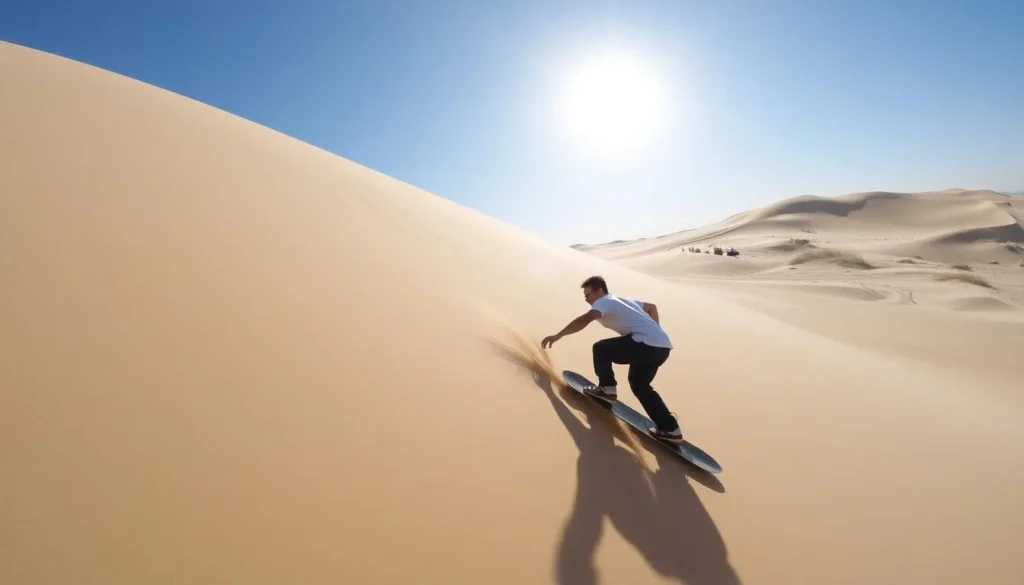
Experience the thrill of sandboarding down the Oregon Dunes, a unique adventure that combines the excitement of snowboarding with the challenge of sandy slopes. Sandboarding is an exhilarating activity that’s similar to snowboarding but on sand, offering a fresh way to experience the towering dunes.
Sand Master Park: A Sandboarder’s Paradise
Sand Master Park in Florence is the world’s first facility dedicated to sandboarding, spanning 40 acres with specially designed slopes for all skill levels. You can rent specialized sandboards and wax to glide smoothly down the dunes. The park is equipped with beginner-friendly slopes, as well as steeper slopes, jumps, and rails for more experienced riders.
Beginner Tips for Sandboarding Success
For those new to sandboarding, the beginner-friendly slopes at Sand Master Park are ideal for learning the basics of balance and steering. Unlike snow, sand is more forgiving when you fall, but it’s still important to wear comfortable clothing and stay hydrated. Here are some key points to consider when sandboarding:
- Try sandboarding at the Oregon Dunes for a unique experience.
- Rent specialized sandboards designed to glide on sand.
- Take advantage of beginner-friendly slopes to learn the basics.
- Plan your visit around the annual sandboarding festivals.
- Wear comfortable clothing that can get sandy and stay hydrated.
Wildlife Watching Opportunities in the Recreation Area
With its unique blend of coastal, forest, and freshwater habitats, the Oregon Dunes is a prime location for spotting a wide variety of wildlife. The diverse ecosystems within the recreation area support a rich array of species, making it a haven for wildlife enthusiasts.
Coastal and Forest Wildlife to Spot
As you explore the Oregon Dunes, keep an eye out for seabirds, sea lions, and gray whales offshore. Inland, you might spot bald eagles and osprey soaring above the lakes and forests. The dunes are also home to Roosevelt elk, Oregon’s second-largest land mammal.
Best Locations and Times for Wildlife Viewing
For the best wildlife viewing opportunities, plan your visits to the areas around lakes and forests during early morning or late afternoon when animals are most active. Bring binoculars to enhance your experience, and consider joining a guided tour with a naturalist to help locate and identify the various species.
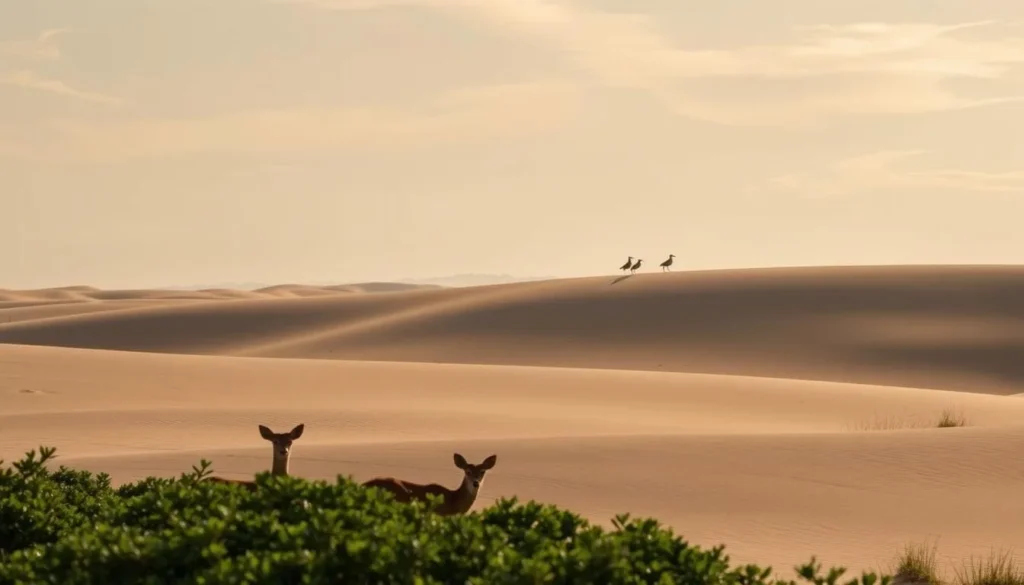
Water Activities: Beyond the Sand
Water activities in the Oregon Dunes National Recreation Area provide a refreshing contrast to the sandy dunes. The area offers numerous lakes, rivers, and beach access points, making it an ideal destination for water enthusiasts.
Paddling the Lakes and Rivers of Oregon Dunes
You can enjoy peaceful paddling experiences on the Siltcoos River, which flows gently for three miles from Siltcoos Lake to the Pacific Ocean. The river offers a scenic water trail suitable for canoes, kayaks, and stand-up paddleboards. For a unique adventure, try paddling through the tree-lined corridors of Tahkenitch Creek or exploring the open waters of Tahkenitch Lake.
Fishing Hotspots in the Recreation Area
Fishing enthusiasts will be pleased to discover that the lakes and waterways in the Oregon Dunes are home to various fish species. Siltcoos and Tahkenitch lakes are known for seasonal salmon runs, while other bodies of water are stocked with trout and bass. 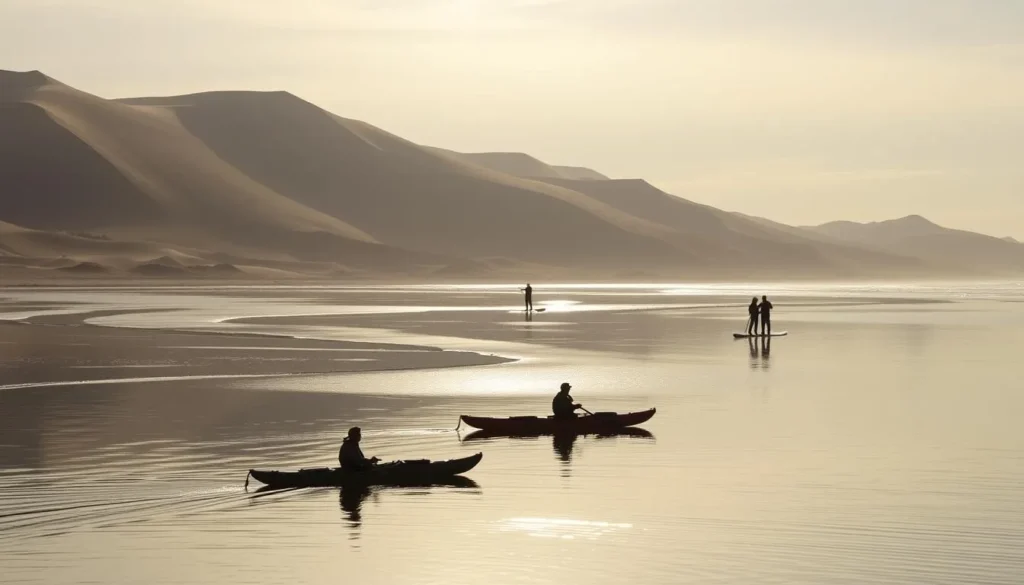 Always check weather forecasts and wear appropriate safety gear when engaging in water activities.
Always check weather forecasts and wear appropriate safety gear when engaging in water activities.
Oregon Dunes National Recreation Area, Oregon: Best Things to Do – Top Picks for Families
The Oregon Dunes National Recreation Area is a paradise for families, offering a mix of adventure and relaxation. With over 40 miles of coastline, it’s the largest coastal sand dunes in North America, providing a unique landscape for various activities.
Kid-Friendly Activities and Adventures
Your kids will love sledding down the smaller dunes using plastic discs or cardboard, a simple yet fun activity. The Oregon Dunes Day Use Area is perfect for families with young children, featuring a short trail to the beach and a viewing platform. You can also explore tidepools at low tide, discovering marine creatures like sea stars and anemones.
Family-Friendly Trails and Viewpoints
For a more relaxed experience, visit Jessie M. Honeyman Memorial State Park, where you can enjoy swimming, fishing, and paddling in the freshwater lakes. Guided dune buggy tours are another exciting way to explore the vast dunes together as a family. The visitor centers offer interactive exhibits and junior ranger programs, making learning fun for kids.
Camping Under the Stars: Overnight in the Dunes
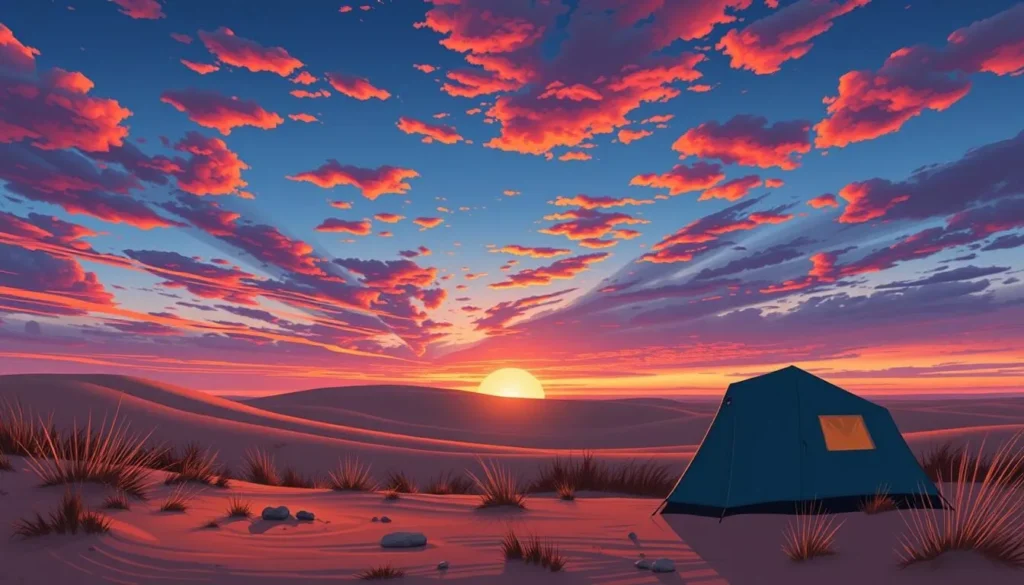
Experience the magic of the Oregon Dunes under the stars with a camping trip like no other. The Oregon Dunes National Recreation Area and the Siuslaw National Forest offer numerous camping options, ranging from rustic sand campsites to developed campgrounds with all the amenities.
Top Campgrounds in and Around the Recreation Area
You can choose from several developed campgrounds within and around the recreation area, including Carter Lake Campground, Eel Creek Campground, Lagoon Campground, and Spinreel Campground. For a more traditional camping experience with facilities, Jessie M. Honeyman Memorial State Park provides over 350 campsites, including yurts for rent and hot showers.
Sand Camping: A Unique Dunes Experience
If you’re seeking a truly unique overnight adventure, try sand camping in designated areas. You’ll set up your tent directly on the sand and fall asleep to the gentle sounds of the wind sculpting the dunes around you. Be sure to bring extra stakes or sand anchors for your tent and protect your gear from blowing sand.
Hidden Treasures: Mushroom Hunting and Foraging
The Oregon Dunes National Recreation Area holds a secret that’s a treasure for many: an abundance of wild mushrooms waiting to be discovered. In the fall, the forested areas around the dunes offer dedicated mycophagists huge quantities of chanterelles, boletes, matsutake, and lobster mushrooms.
Seasonal Mushroom Varieties and Where to Find Them
You can find an abundance of prized edible mushrooms in the Siuslaw National Forest, including golden chanterelles, porcini (boletes), matsutake, and vibrant lobster mushrooms. The best mushroom hunting conditions typically occur after fall rains have moistened the forest floor, usually from late September through November.
Permits and Guidelines for Responsible Foraging
For personal use, you’re allowed to harvest up to one gallon of mushrooms per day without a permit. If you’re new to mushroom foraging, stop by the Oregon Dunes Visitor Center for maps, identification guides, and expert advice. Always carry a quality field guide and only harvest mushrooms you can positively identify.
- Visit the Oregon Dunes in fall for prime mushroom hunting opportunities.
- Check with the Oregon Dunes Visitor Center for the latest information on mushroom locations and conditions.
- Be sure to follow guidelines for responsible foraging to preserve the ecosystem.
Scenic Viewpoints and Photography Opportunities
As you explore the Oregon Dunes National Recreation Area, you’ll discover numerous vantage points that showcase the breathtaking beauty of this unique landscape where forest, sand, and ocean meet.
Must-Visit Overlooks and Vistas
The Oregon Dunes Day Use Area offers an elevated viewing platform with spectacular panoramic views of the sweeping dune landscape stretching toward the Pacific Ocean. For dramatic coastal scenery, head to the Heceta Head Scenic Viewpoint north of Florence, where you can photograph the historic lighthouse perched on rugged cliffs above the beach.
Tips for Capturing the Dunes’ Dramatic Landscape
The changing light throughout the day transforms the appearance of the dunes. Early morning and late afternoon provide the most dramatic shadows and textures, while midday offers the brightest sand colors against blue skies. Look for natural leading lines created by ripples in the sand or footprints to create depth in your images.
| Location | Best Time to Visit | Photography Tips |
|---|---|---|
| Oregon Dunes Day Use Area | Early morning or late afternoon | Use natural leading lines to create depth |
| Heceta Head Scenic Viewpoint | Midday for lighthouse views | Capture the historic lighthouse with the dunes in the background |
| Devil’s Churn | During high tide | Photograph the wave-pool effect |
Conclusion: Embracing the Ever-Changing Dunes
With every visit to the Oregon Dunes, you’re witnessing a unique moment in time, as the sand, wind, and sea continually reshape the landscape. The dunes are always in motion, never looking exactly the same from one day to the next. Whether you hike, ride an off-road vehicle, try sandboarding, or simply relax, your experience will be unforgettable.
As you plan your visit, remember that you’re entering a dynamic natural place where preservation and recreation coexist. Your responsible enjoyment helps ensure the Oregon Dunes remain pristine for future generations. Consider returning in different seasons to witness the transformations throughout the year.
Leaving the dunes behind, you’ll carry a deeper appreciation for the power of natural forces and the beauty they create. The sand may remain in your shoes, but the memory of this unique meeting of forest, sand, and sea will stay with you.

